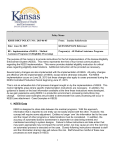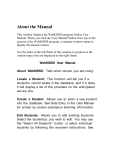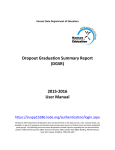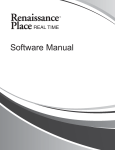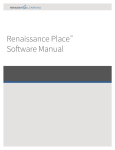Download Pre-Leadership Conference 2013
Transcript
Pre-Leadership Conference 2013 Presenters – Mason Vosburgh, KSDE Early Childhood Special Education Title Services Data Manager ([email protected]) – Tiffany Smith, KSDE Early Childhood Special Education Title Services 619 Coordinator ([email protected]) – Tim Berens, KSDE TASN GSTAD Project Grant Coordinator ([email protected]) July 24, 2013 Pre-Leadership Conference 1 Leadership Conference 2013 MIS Session Agenda of Topics • • • • • • • • Help with KIDS Records Directory Updates Report Guidance K – Time Tips Other Tips Data Dictionary On the Horizon Changes K_S Application Upgrade 2 Mason Vosburgh July 24, 2013 Pre-Leadership Conference 2 Parochial School KIDS Records by USD • When a private school won't cooperate and send the public school building as the funding or attendance school on a KIDS Collection record, we offer the following as a solution to your local KIDS administrator • Public school should send a KIDS ASGT record type Put the private school building as the AYP, USD building as the funding, The appropriate attendance building, Report all remaining required KIDS data, but: Leave the Student ID (KIDS) number blank. • • • • • The USD will get back from the system a list of students with near matches. The USD then selects the correct student and the association is then made. 3 KIDS Records • To report a student on an IEP, there has to be an association of the student to the organization. This association is made in the KIDS Collection system. – What does it look like? » Association is made with the ID, district / buildings and School Year » Items is orange populate the student record in KAN_Service Mason Vosburgh 4 July 24, 2013 Pre-Leadership Conference 3 KIDS Records • What does no record submitted it look like? – You see no data in the rows under each column Where do you find these records? In KIDS Collection system – student history – by school year. 5 Directory Updates • Directory is open for data entry • If Coop or Interlocal level programs have class schedules and session, the local director of SPED has permissions to update these sessions • New directory field – Contact e-mail for student record exchanges 6 Mason Vosburgh July 24, 2013 Pre-Leadership Conference 4 Directory Updates • Foundations for School Success • New organization (E0) in the directory with new buildings used for assigning KIDS ID numbers for preschoolers. – These programs will be set up by operators of private or community based preschool programs – They will enter all required directory data for their program – They may enter schedule information – They will mark which USD they are bounded by 7 Directory Updates / Data Entry • What if a Foundations student is on an IEP? – Minimal ramifications, standard reporting requirements apply – A KIDS collection record is required to associate the student to the USD. List USD district central office as the funding school. – If the Foundations program is in a school building, use the school building as location of services. – If the Foundations program is in a private or community based preschool, use the local private or community based preschool in the directory as location of services. » Clerks will report all other MIS data is a similar way as any other preschooler on an IEP. 8 Mason Vosburgh July 24, 2013 Pre-Leadership Conference 5 Reports Tips • KAN_Service delivers reports in PDF or Excel formats • Reports are found on the navigation pane • Indicator, Projected and Final –Reports 9 Reports Tips • Sorting and filtering – Excel files have default safety features the prevent accidental corruption of the spreadsheet data – A protected view banner • Recommendation – Disable these defaults before sorting and filtering • Enable editing first, unwrap text and remove merge and center 10 Mason Vosburgh July 24, 2013 Pre-Leadership Conference 6 Reports Tips • Excel – Many clerks create reports that contain duplicate student records (depending on how the data was entered). • Recommendation – Use the Remove Duplicate tool found on the “Data” tab 11 Reports • Excel Concern – Several clerks have express that their Excel skills are not as good as they should be or in some cases have no Excel skills at all • Recommendation – Have you clerk take an Excel class to come up to speed. • Most high schools have classes that focus on Microsoft products such as Excel. » Excel could be given as a day long in-service for your clerks 12 Mason Vosburgh July 24, 2013 Pre-Leadership Conference 7 State Level Reports 13 State Prevalence using K-12 reports (43598 + 22712) / 514103 = 12.89% 14 Mason Vosburgh July 24, 2013 Pre-Leadership Conference 8 K – Time Stuff • Remember collecting participation in K-time programs put students age 3-5 in a better LRE category • Several MIS clerks have never reported any K time participation. • Several MIS clerks have never set up their MIS to account for K – time even if the student participates. » Question for directors, why? 15 K – Time Questions • Do I need to report every minutes of participation in regular early childhood programs without support as k – time, is the more the better? • The OSEP benchmark is 10 hours a week – 600 minutes – If child participation is less than 10 hours, yes it helps to report up to 10 hours per week • Some kindergarteners have little IEP support, is it better to report all time outside of special education as K time. » Once over 10 hours you are in the good category, additional time keeps the same category. To avoid doing the math on a daily basis, a short cut can be made. » For example Student X does not get support 2 days a week. The school day is 390 minutes. Listing K time for 390 minutes, 2 days a week gets you in the good category with 780 minutes. 16 Mason Vosburgh July 24, 2013 Pre-Leadership Conference 9 K – Time Questions • If I use a short cut, will it cause a verification? – Yes, only if the service time and + K – Time exceed the daily session • How do I know if the students are in the good category or not? – Each student record that counts on December 1 has a 2 letter “OSEP Environment” code on student profile and in the Dec.1 final report – T = Total minutes in regular early childhood program is ≥10 hrs. – U = < 10 hours – M = Majority ≥ 50% of IEP services occur regular early childhood program – L = Less < 50% of IEP services occur regular early childhood program » Possible Combinations: » TM TL » UM UL 17 K – Time Questions • What if there is no participation at all in Regular early childhood programs? – Then the student will fall in another “OSEP Environment” depending on the service locations reported. • SP = Separate class • SS = Separate School • HO = Home • PL = Service provider location 18 Mason Vosburgh July 24, 2013 Pre-Leadership Conference 10 Data Reporting Tips • Private / Parochial school calendars • Be sure to discover the real calendar local Private / Parochial schools follow. • They may not be the same as the local USD • This directly effects several indicators, including LRE, child find etc. – Wrong calendars can have a negative effect on these Indicators 19 Data Reporting Tips • Recommendations • Check your preliminary December 1 report. • Use Excel to find anomalies, you may find – 5 year old students in 4th grade – Kindergarten students in preschool classrooms only • Why, clerks are not changing location of service when student transitions to Kindergarten 20 Mason Vosburgh July 24, 2013 Pre-Leadership Conference 11 Verification Clarification • Verifications apply to a school year • December 1 and June verifications are combined • Recommendation – Only re-enter a student record if the data has changed. • Why? – New imports remove resolved verifications and result in the same error to be corrected again » Track exports and imports in local IEP programs to avoid reimporting a record with no data changes. 21 Importing Clarification • Each record has an internal ID number (X211P82) • Records may be imported to: – fix verifications – Update IEP services, etc. • The act of importing removes the original record and replaces with the new. – The original record counted on December 1. Table 1 = Yes » New imports of the same student does not say Table 1 = Yes » Why? » Because the record that counted (X211P82) was deleted upon import. The student (by name) is 22 listed on the 12-1 report by the prior record. Mason Vosburgh July 24, 2013 Pre-Leadership Conference 12 Importing Issues • Duplicate records can be created if the new imports have a different responsible building. – How to prevent duplicate records • Change the responsible building to the new building in the existing record prior to import. – Match is made, New record replaces original record • Delete the original student profile for the school year prior to import. New record becomes the only record. 23 Data Dictionary Stuff • New terminology – Term AYP school has changed - New term • Accountability School • Accountability School ID (building number) – Used as the “Responsible school” in K_S – Term “Extracted” is used to better describe how KSDE gets LEA data for the federal 618 submissions. » Additional data is not required to be submitted to KSDE outside of KAN_Service for the OSEP reporting requirements. 24 Mason Vosburgh July 24, 2013 Pre-Leadership Conference 13 Data Dictionary Stuff • Reporting Standard Added – Keep the data as current and up to date as possible • Monthly updates at a minimum • Constraints were added to the file specifications to clarify what fields are required, optional, or conditional • Re-Evaluation Completion Date – clarification added 25 Data Dictionary Stuff • How to create data files is addressed in terms of the collection for the school year, not as 2 points in time. • Clarification to the K- Time setting added to address the 10 hour / 600 minute per week participation. 26 Mason Vosburgh July 24, 2013 Pre-Leadership Conference 14 Data Dictionary Stuff New Basis of Exit Status Code “S” – services cease due to suspension or expulsion What students can use this code? Gifted only, - Eligibility / funding code 4 When can the code be used? When a gifted only student is subject to a suspension or expulsion and services are no longer provided. Are there additional exiting requirements? No, the same rules for reporting exits apply. Exit date and service end date are equal, mark gap in service when student returns, etc. 27 On the Horizon Changes • Consolidation of reporting all pullout locations to a single setting code of “G” – Ramification – remove the “F” code – Why? • Inconsistencies, many clerks report preschool pull out of “F” for students grades KG and higher • A 5 year old and a 6 year sit side by side, 1 is “F”, 1 is “G” • Simplify the begin year set up for the MIS clerks » Effect on LRE calculation - none 28 Mason Vosburgh July 24, 2013 Pre-Leadership Conference 15 On the Horizon Changes • Extension of the December 1 collection window – OSEP is proposing a later due date in April – This may mean an extension of the finalization of data by the LEA from February 28 • How will this work? – KSDE will run the preliminary child count for LEA review in January – KSDE will run the final report and lock the data in te last week of March 29 K_S Application Upgrade Summer 2014 • Improvements to sync with KIDS functions • Removed 54 verifications, fixed logic for 11 • Improvements to IEP and Evaluation due date reports – MIS clerk request, target dates are now optional • Improvements to year to year data rollover • Added navigation buttons on student records –For easier movement between pages 30 Mason Vosburgh July 24, 2013 Pre-Leadership Conference 16 K_S Application Upgrade Summer 2014 • Removed calculation process from verification routine to speed up process. Run calculations is a now a separate process. • Improvements to Indicator 12 • Report document added to assist with resolving overlapping students • Improvements to roster reports » Additional data fields added to Final OSEP reports. 31 Indicator 20 • Please remind your MIS clerks – Attaching confidential student information to e-mail is in violation of KSDE security policy. • Doing so can result in a loss of point on Indicator 20. – Reporting program locations such as the K Time day care building for participation time in elementary school buildings (for example), may be considered inaccurate reporting amd resulting in a loss of Indicator 20 points. 32 Mason Vosburgh July 24, 2013 Pre-Leadership Conference 17 Questions . 33 Mason Vosburgh July 24, 2013 Pre-Leadership Conference 18 IDEA Indicator 12 Early Childhood “Transition Referral System” Pre-Leadership Conference MIS Presentation July 24, 2013 Tiffany J. Smith KSDE Early Childhood Special Education Title Services (ECSETS) [email protected] Why More? • Need for further accountability with specific referral dates and reconciliation “real-time” rather than annually • Part C is required to notify both LEA and SEA of all referrals, including dates and results of referral • Ensure referral is made to the accurate district where the child resides, as required by law 7/24/2013 Pre-Leadership Conference Tiffany Smith 2 July 24, 2013 Pre-Leadership Conference 19 Accessing New Kansas IDEA EC Transition Referral System • Identify and designate staff who will be responsible to updated transition referral system with KDHE. • Send information to Beccy Strohm [email protected] and include: position title, first and last name, USD #’s, Special Education Coop (if appropriate), phone number and email address. • KSDE will notify KDHE those school personnel who will have access and staff will set up account with password information. 7/24/2013 Pre-Leadership Conference 3 Transition Referral System 7/24/2013 Pre-Leadership Conference Tiffany Smith 4 July 24, 2013 Pre-Leadership Conference 20 LEA - SEA Referral Reconciliation System 7/24/2013 Pre-Leadership Conference 5 7/24/2013 Pre-Leadership Conference 6 Tiffany Smith July 24, 2013 Pre-Leadership Conference 21 7/24/2013 Pre-Leadership Conference 7 7/24/2013 Pre-Leadership Conference 8 Tiffany Smith July 24, 2013 Pre-Leadership Conference 22 Early Childhood, Special Education, and Title Services Date: May 6, 2013 To: Special Education Directors/Early Childhood Coordinators/Early Childhood Transition Coordinators From: Tiffany Smith Re: Accessing New Kansas IDEA Early Childhood Transition Referral System for State Performance Plan (SPP) Indicator 12 States must have in place policies and procedures to ensure a smooth transition for toddlers receiving early intervention services under Part C to preschool or other appropriate services, or exiting the program for infants and toddlers with disabilities. (Part C regulation §303.209(a)(1)(i) and (ii)). To meet this regulation, the Office of Special Education Programs requires transition referral data reported from KDHE Part C Infant-Toddler Programs and KSDE Part B 619 be mutually agreed and approved by both agencies. In addition, the recent promulgation of regulations for IDEA Part C includes a requirement that the SEA be notified of all referrals to the appropriate district (§303.209(b)). To improve the accuracy of data reported by both KDHE and KSDE, a new reporting method outlined in this memo is being established to meet these regulatory requirements and assist the state in the goal of promoting collaborative, timely, and effective transition practices for children transitioning from Part C to Part B early childhood special education services. A real-time web-based application for the collection of early childhood transition referral data has been created and will be referred to as the “Transition Referral System.” The Transition Referral System will contain specific referral dates for children transitioning from Part C tiny-k programs to LEA’s and/or Special Education Cooperatives. The data provided by the local tinyk programs for this system will include all elements of a required referral (child’s name, parent(s) name(s), address, and contact information). Districts will mark each referral as either accepted (the child resides in their district) or rejected (the child does not reside in their district), and be able to print out or save listings of accepted or rejected referrals. Tiny-k programs will be instructed to continue their current practice of contacting the district by phone or email for referrals. The electronic reporting element is an addition to assist with monitoring and will also ensure the referral to the appropriate responsible LEA and SEA. The Transition Referral System will allow for confirmation of the accuracy of referral dates reported by both tiny-k and local Part B programs and will assist with the verification of required timelines for compliance. Processes established in connection with the reporting will assist local tiny-k programs, LEAs and the SEA in resolving any rejected referrals in a timely manner. Please note the new Transition Referral System does NOT eliminate the current data collection by KSDE for Indicator 12. KSDE will also continue the current process to capture other required data elements for the Part B indicator 12 collection. Tiffany Smith July 24, 2013 Pre-Leadership Conference Early Childhood, Special Education, and Title Services Access to the Transition Referral System requires prior approval from KSDE and password authentication for entry. This ensures personally-identifiable data in the system is secure and confidential. To enter data and accept referrals from local tiny-k programs, districts must designate staff members who they would like to have access to the system. Please use the attached excel sheet to identify responsible staff by position title, first and last name, USD number(s), Special Education Coop (if appropriate), phone number, and email address and send to Becky Strohm at [email protected] by June 30, 2013. These individuals will have access to the early childhood Transition Referral System when it becomes operational (on or before August 1, 2013. You will also need to update your list with KSDE as you identify new staff who need to have access to the system and as staff leave or change. Further information and a User’s Manual for the new Transition Referral System will be made available at the leadership conference in July. Also, please keep your superintendent(s) informed of this process so they will be aware of the information being collected by KSDE. For further clarification or questions, please contact Tiffany Smith at [email protected] or 785296-1944 Thank you for your assistance. Tiffany Smith 23 July 24, 2013 Pre-Leadership Conference 24 The LEA/SEA Referral Reconciliation System was developed to create an easy, efficient method for locating and reconciling discrepancies found in child records during the Part C to Part B transition process. The purpose of this system is to prevent multiple State IDs (KIDS IDs) from being assigned to the same child, and to ensure that the information being transferred is accurate. Part B User Manual System Access The system may be accessed by logging into the KSITS web system at https://www.ksits.net. Upon login, Part B (KSDE) users will be automatically directed to the LEA-SEA Referral System. Main Screen The main screen of the system contains two tabs, Referral System and Reports. The Referral System tab is selected by default when the system is first opened. In this tab there are two list boxes and 4 buttons used for selecting the districts to open. The list box on the left shows the school districts available for the user to select. The list box on the right shows the currently selected districts to be opened. To select a district to open, first select it from the list on the left, then press the "Include Selected >" button. You will now see the selected district in the list on the right. To select all districts, press the "Include All >>" button. You will now see ALL districts in the list on the right. Use the "< Remove Selected" and "<< Remove All" buttons to remove them from the list of districts to open. Once you have the selected the districts you wish to open, press the "Open" button to open the Referral System for the selected districts. Referral System Once you have selected the district(s), the Referral System will be opened. The Referral System contains 4 tabs- Open Cases, All Cases, Accepted, and Rejected. The Open Cases tab is selected by default when the system is opened. The grid is filled with cases which have been referred to Part B and have not yet been accepted or rejected by your agency. Cases may be accepted, rejected as unknown, or rejected for other reason by marking the checkbox for each case and then pressing the appropriate button at the top of the screen. All cases may be selected by marking the checkbox at the top of the grid. Cases Rejected for Other reason require a reason to be selected. When this option is selected, a screen will appear with a list of the cases selected and a drop down list to select the reason for rejecting. Use the tabs to view all cases, only cases which have been accepted, or cases that have been rejected. When viewing these tabs, an additional option to reopen cases is available. Tiffany Smith July 24, 2013 Pre-Leadership Conference The Return to Lookup button will close the Referral System and return the user to the main screen. Reports The Reports tab on the main screen allows users to run reports by district and within a specified date range. Users may select to run the report for All cases, Open cases, Accepted cases, or Rejected cases. Districts are selected in the same manner as mentioned for the referral system. Reports will only show cases for the districts shown in the list box on the right. Once the districts have been selected, choose the desired report from the drop down list, then enter the date range the report should include referrals for. Press the Run Report button to create the report. The report will then open in a new window for viewing and may be downloaded as a PDF, XLS, HTML, or RTF file for future use or printing. Tiffany Smith 25 July 24, 2013 Pre-Leadership Conference 26 Contact Information • Contact Beccy Strohm [email protected] for form needed to submit information for access • Other questions? Contact Tiffany Smith [email protected] or 785-296-1944 • Indicator 12 information: http://www.ksde.org/Default.aspx?tabid=2291#Ind12 • Early Childhood Special Education Contacts for both Part C and Part B: http://www.ksde.org/Default.aspx?tabid=4745 7/24/2013 Pre-Leadership Conference 9 Additional Questions? 7/24/2013 Pre-Leadership Conference Tiffany Smith 10 July 24, 2013 Pre-Leadership Conference 27 Federal Fiscal Year 2012 (SY 2012-13) APR Data Reported on March 15, 2014 Pre-Leadership Conference MIS Presentation July 24, 2013 Tim L. Berens KSDE TASN General Supervision Timely Accurate Data (GSTAD) Project [email protected] Indicator 12- Transition from Part C to Part B • Indicator 12 measures the percent of children Transitioning from Part C to Part B whose IEP or Eligibility meeting was held before the child's third birthday Target: 100% – FFY 2012 (FY2013) Indicator 12 Data Collection via Kan_Service – A reason must be provided when the IEP or Eligibility meeting was not held before the child's third birthday • Process – – – – 7/24/2013 KDHE sends FFY 2012 (FY2013) C to B Referrals to KSDE In Aug KSDE sends LEAs FFY 2012 (FY2013) C to B Referrals In Aug LEA examines each Part C to B Referral and enters data LEA returns the completed FFY 2012 (FY2013) C to B Referrals to KSDE by Sept 15th Pre-Leadership Conference Tim Berens 12 July 24, 2013 Pre-Leadership Conference 28 Indicator 12- Post Data Review Compliance Results Tabulation 7/24/2013 Pre-Leadership Conference 13 Indicator 12- Post Data Review Compliance Results Tabulation Full page version on page 39 7/24/2013 Pre-Leadership Conference Tim Berens 14 July 24, 2013 Pre-Leadership Conference 29 Indicator 12 Data Review • Indicator 11 measures the percent Initial Evaluations completed within 60 school days Target: 100% – Data Verification period – More information can be found in the Kansas Integrated Accountability System document at http://www.ksde.org/Default.aspx?tabid=2037 7/24/2013 Pre-Leadership Conference 15 Indicator 11- Child Find (Timely Evaluations) • Indicator 11 measures the percent Initial Evaluations completed within 60 school days Target: 100% • The 60 School Day Initial Evaluation Timeframe – For the purposes of measuring compliance with the Federal 60 day evaluation timeline, the timeline for Eligible and Not Eligible students begins with the date the Consent for Evaluation Received and ends with date of the Eligibility Determination Meeting 7/24/2013 Pre-Leadership Conference Tim Berens 16 July 24, 2013 Pre-Leadership Conference 30 Indicator 11- Child Find (Timely Evaluations) • Indicator 11 measures the percent Initial Evaluations completed within 60 school days Target: 100% – Data Collection Window Opened July 1, 2013 – Some districts have reported their results – Data Collection Window Closes September 15, 2013 7/24/2013 Pre-Leadership Conference 17 Indicator 11- Post Data Review Compliance Results Tabulation Full page version on page 38 7/24/2013 Pre-Leadership Conference Tim Berens 18 July 24, 2013 Pre-Leadership Conference 31 Indicator 11- Child Find (Timely Evaluations) • Indicator 11 measures the percent Initial Evaluations completed within 60 school days Target: 100% – Data Verification period – More information can be found in the Kansas Integrated Accountability System document at http://www.ksde.org/Default.aspx?tabid=2037 7/24/2013 Pre-Leadership Conference 19 Indicator 7: Early Childhood Outcomes • Indicator 7 Verification – End of July Memo will ask you to verify: – The children who entered an Early Childhood program during FFY 2011 (FY2012) have been entered into the Early Childhood Outcomes Web System (OWS system) – The children who exited from Early Childhood during FFY 2011 (FY2012) have been entered into the Early Childhood Outcomes Web System (OWS system) – The Kan_Service Indicator 7 Entry and Exit can be used to verify the FFY 2010 (FY2012) Indicator 7 data 7/24/2013 Pre-Leadership Conference Tim Berens 20 July 24, 2013 Pre-Leadership Conference 32 Indicator 7: Early Childhood Outcomes • Indicator 7 Verification – End of July Memo will ask you to verify: – The children who entered an Early Childhood program during FFY 2011 (FY2012) have been entered into the Early Childhood Outcomes Web System (OWS system) – The children who exited from Early Childhood during FFY 2011 (FY2012) have been entered into the Early Childhood Outcomes Web System (OWS system) – The Kan_Service Indicator 7 Entry and Exit can be used to verify the FFY 2010 (FY2012) Indicator 7 data 7/24/2013 Pre-Leadership Conference 21 Indicator 6- EC LRE • Baseline- Dec 1, 2011 Education Environments • Targets- Based on Dec 1, 2011 Educational Environments. • Measurement Against Targets- Dec 1, 2012 Educational Environments will be used to measure performance against Targets and will appear in the FFY 2012 APR • K-Time- factors into Indicator 6A – LRE for children aged 3 through 5 with IEPs attending a Regular early childhood program and receiving the majority of special education and related services in the regular early childhood program. 7/24/2013 Pre-Leadership Conference Tim Berens 22 July 24, 2013 Pre-Leadership Conference 33 Kansas APR Reports • District Level APR Data available on the Kansas APR Reports website – Go to www.ksdetasn.org – Click on the Current Kansas APR Reports (Login Required) link on the left side of screen. – Login (If you need help, contact Tim Berens at [email protected]) – A guide to the reports and the indicators is available by clicking on the View Guide link at the top of the page 7/24/2013 Pre-Leadership Conference 23 Individual District Reports • Expanded Report: – Performance on all indicators regardless of district size – Level of Determination – Rewards and Enforcements 7/24/2013 Pre-Leadership Conference Tim Berens 24 July 24, 2013 Pre-Leadership Conference 34 Individual District Reports • Progress & Slippage Report: – Numerator and Denominator – Whether the Target was met – Whether Progress or Slippage occurred • EC Report: – Numerator and Denominator – Whether the Target was met 7/24/2013 Pre-Leadership Conference 25 Individual District Reports • Numerator Difference Report: – Report the difference between Current Numerator and – Projected Numerator for the next year based next year’s Target and this year’s Denominator – Number of students necessary to meet next year’s Target 7/24/2013 Pre-Leadership Conference Tim Berens 26 July 24, 2013 Pre-Leadership Conference 35 Individual District Reports • Numerator Difference Report: 7/24/2013 Pre-Leadership Conference 27 Individual District Reports • Indicator 20 Report: 7/24/2013 Pre-Leadership Conference Tim Berens 28 July 24, 2013 Pre-Leadership Conference 36 Cluster Reports • Cluster Reports contain data for all districts on one report • Clusters: – – – – – Compliance Cluster: all the compliance indicators Cluster 1: Inds 1, 2, 4, 13 and 14 Cluster 2: Inds 3 and 5 Indicator 20: Ind 20 questions and score sheet score Substantial Compliance and LOD: whether an Indicator is substantially compliant and the Level of Determination – Level of Determination: List of districts and the Level of Determination – Early Childhood Cluster: Inds 6 and 7 7/24/2013 Pre-Leadership Conference Additional Questions? Thank you for attending the Pre-Leadership Conference Meeting Tim Berens 29 EvaluationResult ȗ DistrictLevelIndicator11PostDataReviewComplianceResultsTabulationBusinessRules EvaluationConductedWithin60SchoolDayTimeframe EvaluationNOTConductedWithin60SchoolDay Timeframe Ǥ ͳǤ ʹǤ ̵ Ǥ ͵Ǥ Ǥ 4.Stafferrorcauseddelays. DistrictLevel Indicator12ComplianceStatus 1) IfColumnD=0,100%Compliance.** 2) IfColumnD=1,Noncompliancedemonstrated. 3) IfColumnD>1,Noncompliancedemonstrated. ColumnA: ColumnB: ColumnC: ColumnD. Population Subtracted Initial Evaluations ofall fromthe Evaluations NOT referrals Population within completed ofall Timeline withinthe referrals Timelineas aresultof StaffError (NonǦ Compliance) X *The“Other”reasonsareintheformulaasanothervariable/reason. **WhenusedfortheLevelofDetermination:TheUSDisSubstantiallyCompliantonIndicator11whenthenumberofstusinColD<2. TheUSDisnotSubstantiallyCompliantonIndicator12whenthenumberofstusinColD>2. Tim Berens 37 Pre-Leadership Conference July 24, 2013 District Level Indicator 12 Compliance Status 1. Child moved after eligibility determination and before 3rd birthday. 3 Staff error caused delays in IEP development. 2 Parent repeatedly failed or refused to produce the child for the evaluation. 1 Parent refusal to provide consent caused delays in evaluation or initial services. Process ends. X X X X X X X X X X X Column C: Referrals to Part B on or before 3rd Birthday X X X X X Column D. Referrals to Part B not completed on or before 3rd Birthday as a result of Staff Error (NonCompliance) 1) If Column D = 0, 100% Compliance.** 2) If Column D = 1, Noncompliance demonstrated. 3) If Column D > 1, Noncompliance demonstrated. 2. Parent refused or revoked consent for services X Data Entry Result and Reasons* If IEP on or before 3rd Birthday 3. Staff error caused delays. Column B: Column A: Referrals Population Subtracted of all from the referrals Population If IEP after 3rd Birthday, select IEP Reason Delayed: Process ends X If Eligibility was Determined but an IEP was NOT Written, select a reason the IEP was Not Written: If Eligibility Determination on or before 3rd Birthday, X X X X X X 1. Parent refusal to provide consent caused delays in evaluation. 3. Staff error caused delays. If Eligibility Determination after 3rd Birthday, select Reason Delayed: Reason Eligibility NOT Determined 1. Child moved; or the Parent refused or revoked consent for the evaluation. 2. Parent repeatedly failed or refused to produce the child for the evaluation. Condition District Level Indicator 12 FY 2011 Data Post Review Compliance Results Tabulation Business Rules Referral Result Eligible, IEP Written Eligible, IEP Not Written Not Eligible Eligibility NOT Determined *The “Other” reasons are in the formula as another variable/reason. **When used for the Level of Determination: The USD is Substantially Compliant on Indicator 12 when the number of stus in Col D < 2. The USD is not Substantially Compliant on Indicator 12 when the number of stus in Col D > 2. Tim Berens 38 Pre-Leadership Conference July 24, 2013










































